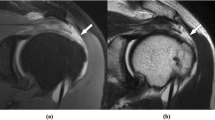Abstract
Objective
Partial thickness tears of the undersurface (articular surface) of the rotator cuff (RTC) have been recognized increasingly in recent years as a source of treatable shoulder pain in the athletic population. This study evaluated the efficacy of MR arthrography (MR-ARTH) in diagnosing these tears.
Design and patients
The study design was a retrospective review of medical records of patients who had presented with refractory shoulder complaints and subsequently undergone MR arthrography with multiple signal MRI sequences followed by shoulder arthroscopy. Of particular interest were patients who had oblique T1 fat suppression (COT1FS), coronal oblique T2 (COT2), and coronal oblique T2 fat suppression (COT2FS) images taken. Seventy-six subjects met the study criteria. Investigators examined the MR-ARTH images from these patients' charts while blinded as to arthroscopic results, clinical signs and symptoms.
Results
Based on COT1FS images, investigators identified nine subjects as having had full thickness tears, 28 as having had partial thickness tears of the undersurface of the rotator cuff (PRTC), and 39 as having had intact RTC. These results were compared to actual findings at arthroscopy: nine full thickness tears, 26 of 28 with PRTC and 34 of 39 intact. The sensitivity of MR-ARTH was 84%, with a positive predictive value of 93%. The overall accuracy was 91% (69/76). The specificity was 96%. That is, if a PRTC was not seen on the MR-ARTH images, it was very unlikely to exist. COT2 and COT2FS sequences failed to increase sensitivity and overall efficacy of MRI.
Conclusion
PRTC can be diagnosed accurately by MR-ARTH with gadopentatate contrast. A COT1FS sequence is recommended for evaluation when tears are suspected.




Similar content being viewed by others
References
Andrews JR, Broussard TS, Carson WG. Arthroscopy of the shoulder in the management of partial tears of the rotator cuff: A preliminary report. Arthroscopy 1985; 1:117–122.
Payne LZ, Altchek DW, Craig EV, Warren RF. Arthroscopic treatment of partial rotator cuff tears in young athletes: a preliminary report. Am J Sports Med 1997; 25:299–305.
Hodler J, Kursunoglu-Brahme S, Snyder SJ, et al. Rotator cuff disease: assessment with MR arthrography versus standard MR imaging in 36 patients with arthroscopic confirmation. Radiology 1992; 182:431–436.
Karzel RP, Snyder SJ. Magnetic resonance arthrography of the shoulder: a new technique of shoulder imaging. Clin Sports Med 1993; 12:123–136.
Nelson MC, Leather GP, Nirschl RP, Pettrone FA, Freedman MT. Evaluation of the painful shoulder. J Bone Joint Surg [Am] 1991; 73A:707–716.
Traughber PD, Goodwin TE. Shoulder MRI: arthroscopic correlation with emphasis on partial tears. J Comput Assist Tomogr 1992; 16:129–133.
Tuite MJ, Yandow DR, DeSmet AA, Orwin JF, Quintana FA. Diagnosis of partial and complete rotator cuff tears using combined gradient echo and spin echo imaging. Skeletal Radiol 1994; 23:541–546.
Wnorowski DC, Levinsohn M, Chamberlain BC, McAndrew DL. Magnetic resonance imaging assessment of the rotator cuff: Is it really accurate? Arthroscopy 1997; 13:710–719.
Flannigan B, Kursunoglu-Brahme S, Snyder S, Karzel R, Del Pizzo W, Resnick D. MR arthrography of the shoulder: comparison with conventional MR imaging. Am J Roentgenol 1990; 155:829–832.
Palmer WE, Brown JH, Rosenthal DI. Rotator cuff: evaluation with fat-suppressed MR arthrography. Radiology 1993; 188:683–687.
Zanetti M, Jost B, Lustenberger A, Hodler J. Clinical impact of MR arthrography of the shoulder. Acta Radiol 1999; 40:296–302.
Walch G, Boileau P, Noel E, Donell ST. Impingement of the deep surface of the supraspinatus tendon on the posterosuperior glenoid rim: an arthroscopic study. J Shoulder Elbow Surg 1991; 1:238–245.
Iannotti JP, Zlatkin MB, Esterhai JL, Kressel HY, Dalinka MK, Spindler KP. Magnetic resonance imaging of the shoulder. J Bone Joint Surg [Am] 1991; 3A:17–29.
Rafii M, Firooznia H, Sherman O et al. Rotator cuff lesions: signal patterns at MR imaging. Radiology 1990; 177:817–823.
Author information
Authors and Affiliations
Corresponding author
Rights and permissions
About this article
Cite this article
Meister, K., Thesing, J., Montgomery, W.J. et al. MR arthrography of partial thickness tears of the undersurface of the rotator cuff: an arthroscopic correlation. Skeletal Radiol 33, 136–141 (2004). https://doi.org/10.1007/s00256-003-0688-z
Received:
Revised:
Accepted:
Published:
Issue Date:
DOI: https://doi.org/10.1007/s00256-003-0688-z




